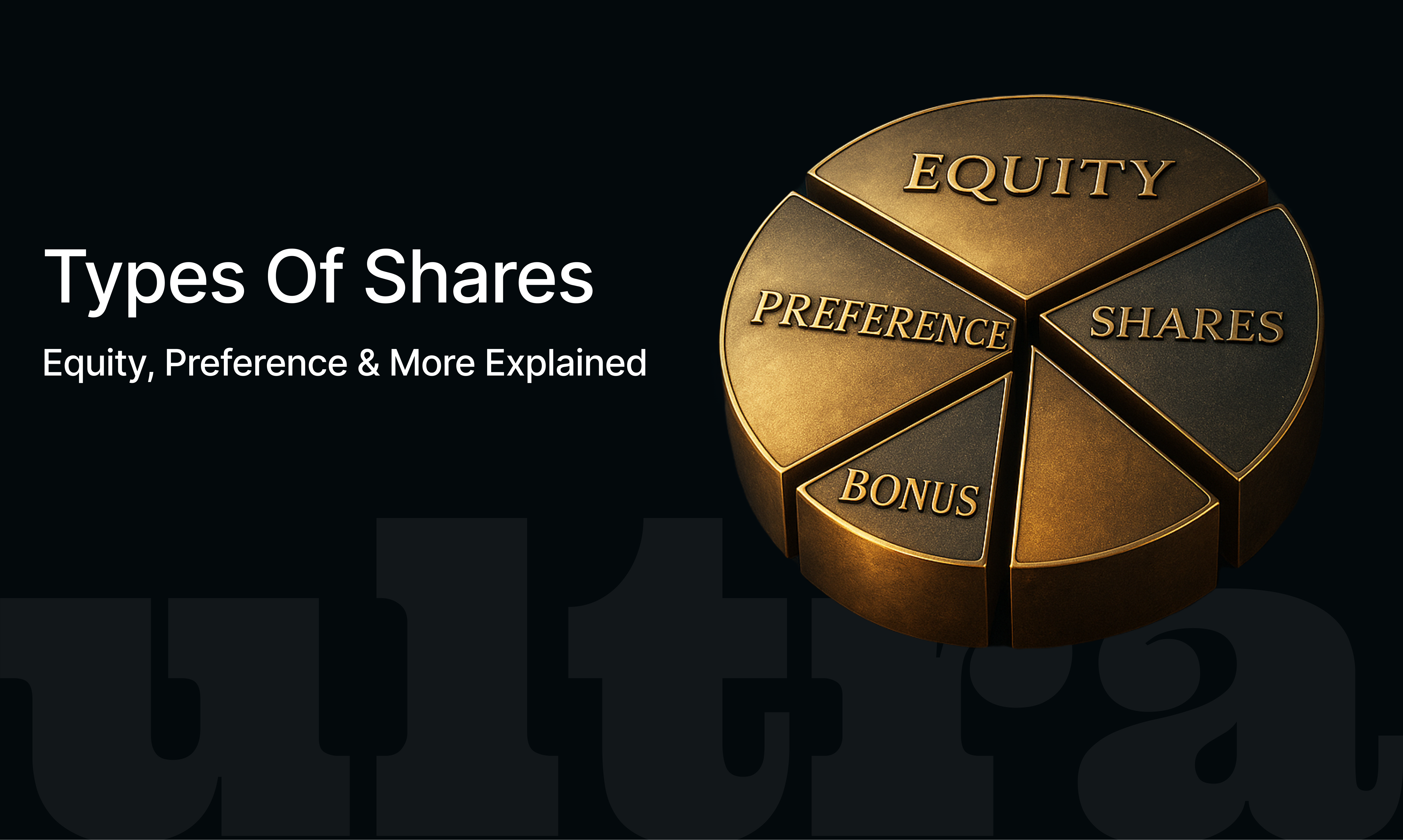Types of Shares: A Complete Guide for Investors
13 August 2025 · Sachin Gadekar
In this guide, we will explore types of equity shares, types of preference shares, their classifications under company law, and how platforms like Ultra can help you access diverse investment opportunities.

Types Of Shares
What Are Shares?
A share represents a unit of ownership in a company. By holding shares, investors are entitled to a portion of the company’s profits (dividends) and may also benefit from capital appreciation if the share price increases.
Companies issue shares to raise capital for expansion, operations, or new projects. Under company law, shares can be broadly classified into two main categories:
Equity Shares – Represent actual ownership and come with voting rights.
Preference Shares – Provide fixed returns and have preferential rights in dividend payments and capital repayment.
Types of Equity Shares
Equity shares, also called ordinary shares, are the most common type of shares issued by companies. They represent ownership and typically carry voting rights. The types of equity shares include:
1. Ordinary Shares
Ordinary shareholders have voting rights and are entitled to dividends after preference shareholders have been paid. Returns depend on the company’s performance.
2. Bonus Shares
Bonus shares are additional shares given to existing shareholders at no extra cost, usually issued from the company’s reserves.
3. Rights Shares
Rights shares are offered to existing shareholders at a discounted price before being offered to the public.
4. Sweat Equity Shares
These are shares given to employees or directors as a reward for their contributions, often issued at a discount or for non-cash considerations.
5. Voting and Non-Voting Shares
Some equity shares carry voting rights, while others may be non-voting, allowing investors to benefit financially without participating in company decisions.
Types of Preference Shares
Preference shares combine features of equity and debt. They offer a fixed dividend and have priority over equity shares in profit distribution and repayment during liquidation. The types of preference shares include:
1. Cumulative Preference Shares
Unpaid dividends accumulate and are paid out in subsequent years before equity shareholders receive dividends.
2. Non-Cumulative Preference Shares
If the company cannot pay dividends in a given year, the right to that year’s dividend lapses.
3. Redeemable Preference Shares
These can be repurchased by the company after a fixed period or upon meeting certain conditions.
4. Irredeemable Preference Shares
These have no maturity date and cannot be redeemed during the company’s lifetime.
5. Participating Preference Shares
Holders receive a fixed dividend plus an additional share in the company’s surplus profits.
6. Non-Participating Preference Shares
Holders are entitled only to a fixed dividend and have no claim on surplus profits.
7. Convertible Preference Shares
These can be converted into equity shares after a certain period.
8. Non-Convertible Preference Shares
These cannot be converted into equity shares and remain as preference shares until redeemed.
Types of Shares in Company Law
Under company law, the classification of shares primarily revolves around equity shares and preference shares, each with subcategories as explained above. The law specifies shareholder rights, dividend distribution, and voting powers for each type, ensuring transparency and investor protection.
For instance, in India, the Companies Act, 2013 regulates the issue of shares, their transfer, and the rights attached to them.
What Are the 4 Types of Shares?
While there are many categories, the four most common types of shares are:
Equity Shares
Preference Shares
Redeemable Shares
Non-Redeemable Shares
These categories can be further divided based on rights, returns, and conversion options.
Types of Share Capital
Share capital refers to the total value of shares a company can issue. The types of share capital include:
Authorized Capital: The maximum amount of capital a company is authorized to raise through share issuance.
Issued Capital: The portion of authorized capital that has been issued to shareholders.
Subscribed Capital: The part of issued capital that investors have agreed to purchase.
Paid-up Capital: The actual amount received from shareholders for issued shares.
How Ultra Helps You Explore Share Investments
Investing in shares requires knowledge and access to the right opportunities. Ultra offers a digital platform where investors can explore multiple asset classes, from listed equity shares to alternative investments, all in one place. With detailed insights, curated options, and a seamless investment process, Ultra helps you diversify your portfolio beyond just traditional shares.
FAQs on Types of Shares
1. What are the two main types of shares?
The two main types are equity shares and preference shares.
2. What are the 4 types of shares?
The most common four are equity shares, preference shares, redeemable shares, and non-redeemable shares.
3. What is the difference between equity and preference shares?
Equity shares offer ownership and voting rights with variable returns, while preference shares offer fixed returns and priority in profit distribution.
4. Which type of shares is best for investors?
It depends on your goals. Equity shares may suit those seeking capital growth, while preference shares are better for stable income.
5. How can I invest in different types of shares?
You can invest via stock exchanges, brokers, or platforms like Ultra that provide diversified investment options.